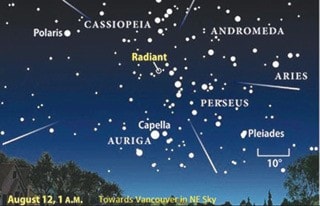What’s up for August’s night skies? See five planets after sunset and the annual Perseid Meteor Shower.
In case you missed the January/February five-planet lineup in the dawn sky, you might have better luck this month.
From Aug. 4 through Aug. 7 spot Venus, Mercury and Jupiter – and the moon – low on the western horizon over Metchosin, about 45 minutes after sunset.
On Aug. 20, the three planets make a pretty triangle five to 10 degrees above the horizon.
Look up in the south-southwest sky over William Head and Port Angeles for a second planetary dance. Mars and Saturn are high and easy to see and are joined by the moon on Aug. 11.
But wait, there are more planets, dwarf planets and an asteroid also visible this month.
Uranus and Neptune and dwarf planet Ceres are visible before dawn in the southern sky over our magnificent Olympic Mountains above Port Angeles.
You may see Uranus through binoculars but Neptune and Ceres require a telescope.
Dwarf planet Pluto is still visible through a telescope after sunset also in the southern sky, as is asteroid Pallas, visible high in the southern sky at the same time.
The constellation Perseus is visible in the northern sky towards the airport, soon after sunset. And the famous and reliably active Perseid meteor shower peaks in the morning hours of Aug. 12, expecting to double its normal rate to 150 to 200 shooting stars per hour.
According to NASA, it will be the first time the phenomena has happened since 2009.
The peak of the meteor shower will be on Aug. 12 and Aug. 13. The comet producing the Perseid meteor shower is called Swift-Tuttle, discovered by astronomers in 1862. You’ll recall that once a year at this time, the earth passes through the very long tail of the comet, so we’re seeing particles of the tail accidentally passing through our atmosphere.
The moon, which paired so nicely with Mars and Saturn on Aug. 11 is bright enough to blot out some of the meteors, but – lucky for you – it sets about
1 a.m. on the morning of Aug. 12, just at the peak time for the best Perseid viewing.
Though you’ll see the most meteors after moonset on Friday morning, Aug. 12, the days on either side of the peak have elevated rates too, and even a week before and after Aug. 12 you’ll see some Perseids.
While waiting for the moon to set and Perseus to climb higher in the sky, aim your binoculars at some of the beautiful nearby objects from within our Milky Way and beyond.
The Milky Way’s Perseus Double Cluster, and the pretty globular clusters of Cassiopeia, can all be spotted with the unaided eye (M-52 and NGC 7789 for labels of the two clusters). The Triangulum and Andromeda galaxies can also be spotted with the unaided eye, but binoculars and telescopes reveal more detail.
Catch up on current missions to comets, Jupiter, Mars and Saturn at jpl.nasa.gov and on all of NASA’s missions at Nasa.gov. Join the RASCals of Cattle Point on their Facebook Page, facebook.com/groups/VictoriaRASCals/ or in person at Fairfield Community Centre, where they meet every Monday at 7:30 p.m.
Dark skies to all friends of Cattle Point Star Park.
Summary is prepared by Bill Smith and the RASCals of Cattle Point, from the transcript of What’s Up in August 2016 by NASA announcer and astronomer Jane Houston Jones with specific permission for localization to Cattle Point DARK SKY Urban Star Park and the Oak Bay News.
